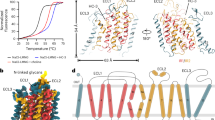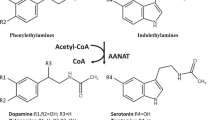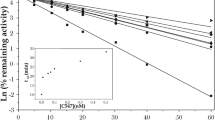Abstract
THE highest concentration of choline acetyltransferase (ChAc) is found in the crude mitochondrial fraction of brain homogenates1 in non-mitochondrial particles2 from isolated nerve endings3. The nerve ending particles obtained by subcellular fractionation of the brain contain a number of synaptic vesicles (or tubules4) and there is little doubt that most of the acetylcholine of the nerve endings is contained in these structures5–7. The localization and binding of ChAc in the nerve ending particles are much more debatable. The enzyme remains firmly attached to the nerve ending particles even when these are washed repeatedly. Treatment with ether or certain other agents is necessary in order to observe its full activity; but even after this treatment the enzyme still remains bound to the particles1, whereas acetylcholine is fully released2. On the other hand, Whittaker, Michaelson and Kirkland8 found that, after exposure to hypo-osmotic conditions, most of the ChAc dissolved, while most of the acetylcholine remained bound to the particles. In their experiments, hypo-osmotic treatment of crude mitochondrial fractions of whole guinea-pig brains caused the release of most of the ChAc, lactate dehydrogenase and potassium ions, all three being released in very nearly the same proportion. This led them to conclude that ChAc is freely dissolved in the cytoplasm within the nerve endings.
This is a preview of subscription content, access via your institution
Access options
Subscribe to this journal
Receive 51 print issues and online access
$199.00 per year
only $3.90 per issue
Buy this article
- Purchase on Springer Link
- Instant access to full article PDF
Prices may be subject to local taxes which are calculated during checkout
Similar content being viewed by others
References
Hebb, C. O., and Smallman, B. N., J. Physiol., 134, 385 (1956).
Hebb, C. O., and Whittaker, V. P., J. Physiol., 142, 187 (1958).
Gray, E. G., and Whittaker, V. P., J. Anat., 96, 79 (1962).
Israël, M., and Whittaker, V. P., Experientia, 21, 325 (1965).
Whittaker, V. P., Biochem. Soc. Symp., No. 23, 109 (1963).
De Robertis, E. D. P., Histophysiology of Synapses and Neurosecretion (Pergamoa Press, Oxford, 1964).
Whittaker, V. P., Prog. Biophys. and Mol. Biol., 15, 41 (1965).
Whittaker, V. P., Michaelson, I. A., and Kirkland, R. J. A., Biochem. J., 90, 293 (1964).
Hebb, C., in Handbuch der experimentellen Pharmakologie, Ergänzungswerk, 15, 55 (Springer Verlag, Berlin, 1963).
Kubowitz, F., and Ott, P., Biochem. Z., 314, 94 (1943).
Author information
Authors and Affiliations
Rights and permissions
About this article
Cite this article
TUČEK, S. Binding of Choline Acetyltransferase in the Nerve Ending Particles of Brain. Nature 212, 1247–1248 (1966). https://doi.org/10.1038/2121247a0
Published:
Issue Date:
DOI: https://doi.org/10.1038/2121247a0
Comments
By submitting a comment you agree to abide by our Terms and Community Guidelines. If you find something abusive or that does not comply with our terms or guidelines please flag it as inappropriate.



